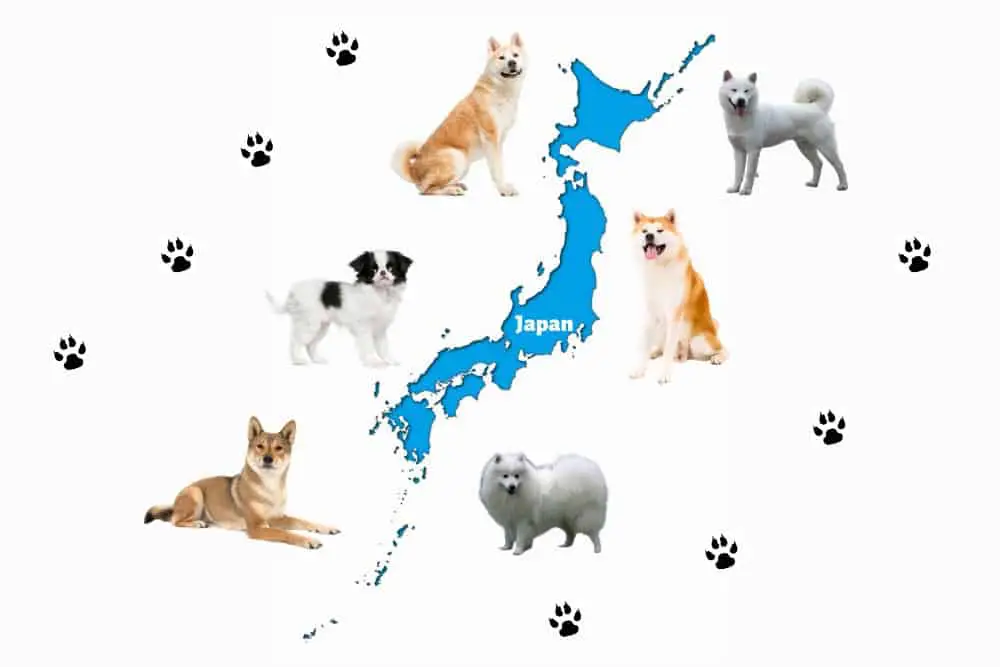There are native Japanese dogs that range in size, appearance, temperament, and talents, which is impressive for a not-so-large country.
In this list of 13 popular Japanese dog breeds, you will see their differences and similarities, their old or new purpose, and why the Japanese people love them so much and are celebrated in their home country.
Let’s dive in.
1. Shiba Inu

Shiba Inus are native dogs to the Chubu region in Japan. Being the fodder for viral videos due to their “Shiba scream,” the Shiba Inu is among the most popular dogs globally, not just in Japan.
They’ve been described as foxlike due to their looks and cat-like due to their cleanliness and unwillingness to get themselves dirty.
Being an easier-to-manage-sized breed has helped them grow in popularity in urban areas. They’re okay with small children but won’t tolerate much roughhousing.
Frequently Asked Shiba Inu Questions:
Did You Know?
- Shibas are considered to be the oldest Japanese small dog
- The Shiba Inu is the most common companion dog in Japan
- They were named after the brushwood bushes where they hunted. (the word Shiba means “brushwood” in Japanese)
- The Shiba Inu is the smallest native Spitz breed from Japan.
- The dog whose picture is the Doge meme is a Shiba Inu.
2. Kai Ken
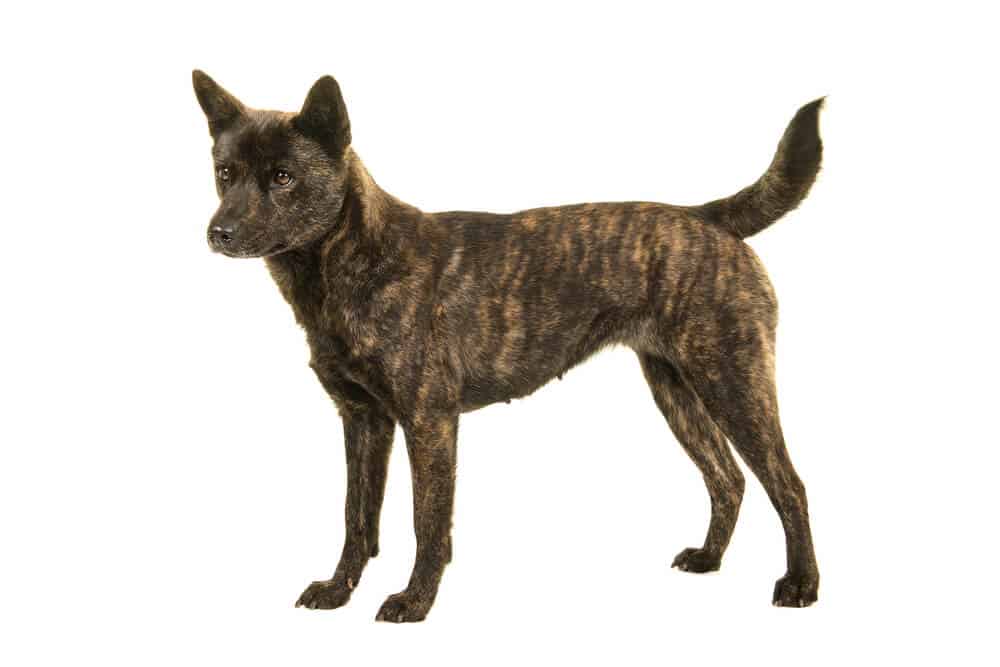
The Kai Ken came from the mountainous regions of Japan and was historically used as a hunting breed for various wild, large or small game. Today, this breed is rare, even in its homeland.
Like the Shiba Inu, they are a clean breed, often staying occupied cleansing themselves but won’t avoid the risk of getting dirty- particularly at play or when on the hunt.
Did You Know?
- Because of the brindle color and stripes, the Kai Ken is often referred to as the “Tiger Dog” in Japan.
- The Kai Ken is often considered the purest of all Japanese dog breeds.
- There are two variations of the Kai Ken – the Shishi-inu-gata type ( stockier body and bear-like face) and the Shika-Inu-gata type (longer, thinner body and foxlike face)
- In Japan, they are regarded as National Treasures and are described as loyal protectors who would lie their lives down for their master.
3. Japanese Chin

The Japanese Chin (also called the Japanese Spaniel) are companion dog through and through and has held that title since its creation.
They are little lapdogs who were meant to be indoors but still like to go out and rough it up on occasion when allowed, akin to most other small dog breeds.
Their face is constructed so that it often has an astonished expression, delighting the hearts of many an owner. They have been a great companion for both royals and commoners alike.
Did You Know?
- President Franklin Pierce was the first to own the Chin in the US.
- The Japanese Chins are ancient dogs that originated as Chinese dog breeds.
- When the Chin first came to Japan, they were not seen as dogs. Instead, they were seen as separate beings.
- They are likened to cats due to their agility and washing their faces with their paws.
4. Tosa Inu
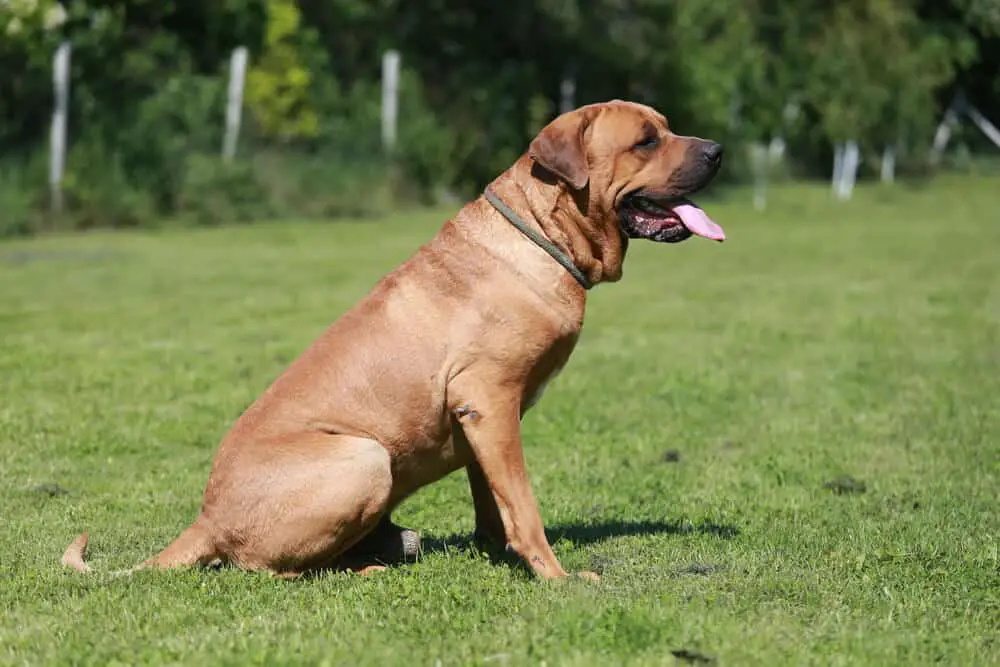
Often referred to as the Japanese Mastiff or the Tosa Ken, Tosa Inu was originally bred in the Tosa region for dogfighting, but those days are long since over.
This good-sized breed is more at home as a loving and good-natured companion or a guard dog.
This breed is not known to be naturally aggressive toward humans. Still, its instincts to become territorial and aggressive toward other animals (other dogs in particular) must be curbed as soon as possible through early training.
This can be a dangerous dog to those outside of its household when left untrained and unchecked and banned from entry into a few countries. With the proper training, this breed can be quiet, affectionate, loyal dogs and are obedient house pets.
Like any large dog breed, they are more prone to suffer from familiar things, such as hip dysplasia.
Did You Know?
- The Tosa is often referred to as the “sumo wrestler” of the dog world
- During World War 2, the Tosa neared extinction
- The Tosa is often depicted in ceremonial regalia
5. Japanese Spitz
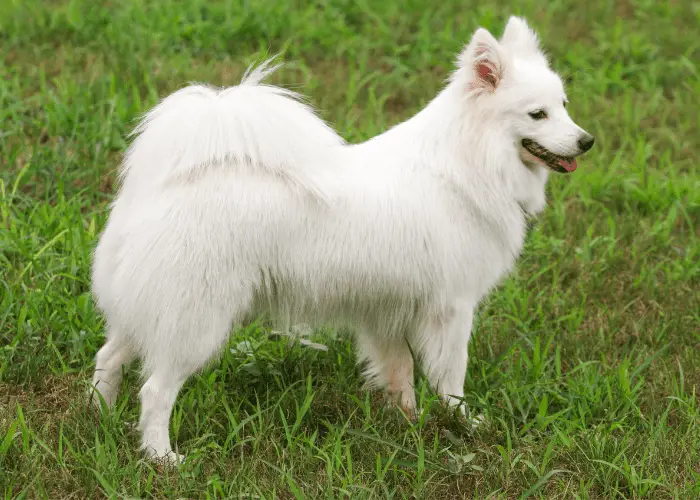
Known to have originated from a culmination of other Spitz breeds, this attractive small to medium-sized breed could be summed up as the class clown of the group.
With its snuggly, long, all-white coat, its stately appearance usually doesn’t prepare one for the comedic antics of which this breed is known.
Their fur gives them a lion-like mane. With their pointy ears sticking through the mane, their coat style resembles what you’d see with a Chow Chow.
Did You Know?
- The American Kennel Club does not recognize the Japanese Spitz because of its close similarity to the American Eskimo Dog.
- The Japan Kennel Club recognized the Japanese Spitz in 1948.
- The breed’s early records were destroyed in World War II, leaving the entire history of the breed a mystery.
- They are fearless protectors and have a bark much louder than you might expect from a dog their size.
- Japanese Spitz is one of the longest-living small breeds, with a life expectancy of 16 years or higher!
6. Kishu Ken
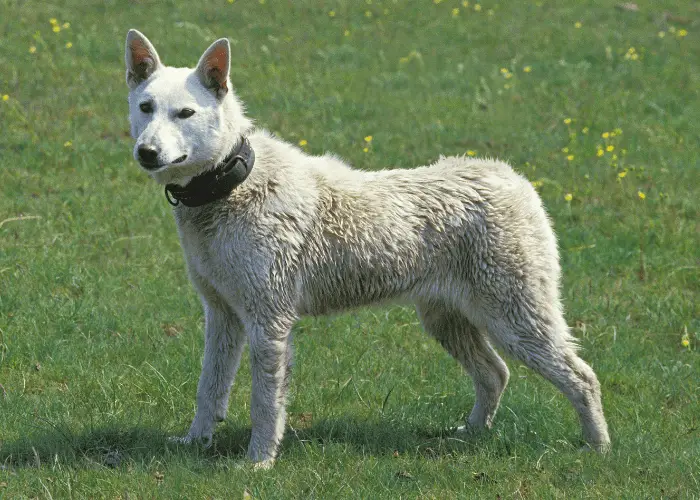
The Kishu Ken (or the Kishu Inu) is a medium to large dog with a Shiba-like look about the face from the Kishu region. They were bred to hunt and chase down wild game in the thick forests, blanketing the hills and mountains of the Kii peninsula.
They’re highly intelligent and trainable, but they will need to be trained early to help curb their high prey drive.
Did You Know?
- Unlike many dogs that go in for the kill, the Kishu is a silent hunter that stalks its prey.
- The Kishu is an excellent climber and can climb trees or cliffs.
- Many people note the Kishu as being an outstanding “escape artist.”
- Sometimes it is mistaken for the Hokkaido dog because of its similar appearance.
- They were designated as a “Memorial of Nature” in Japan in 1935 and are now listed as a National Treasure.
7. Akita Inu
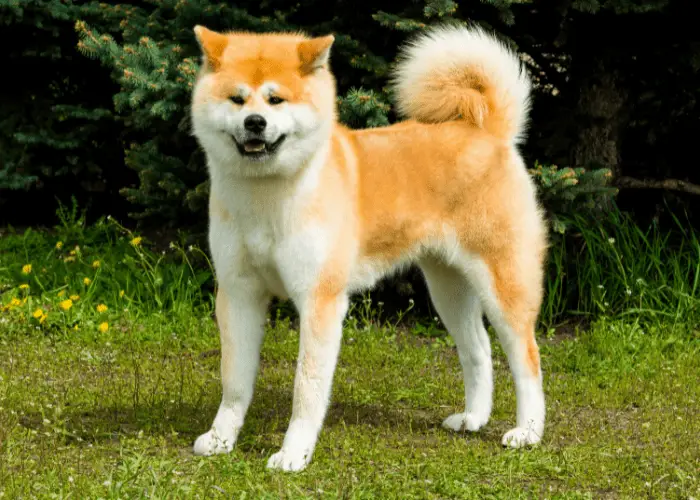
Hailing from Northern Japan, the Akita Inu is known well in Japan for its spirit, beautiful double coat, and endurance. Originally bred as a hunting dog, this breed has held many job titles.
These are energetic hard workers who require stimulation and have high exercise needs.
There is an American variety of this breed originating with the Japanese Akita. The result is an Akita that’s slightly larger than their Japanese counterparts. The United States variety of Akita is a separate breed from that of Japan.
Akita’s are the stuff of local legend in Japan. The story of Hachiko is engrained into the Japanese culture and is about an Akita’s love, loyalty, and long-suffering over his recently deceased owner.
A monument was placed at the train station that was one of the focal points of the story, later on, replaced and relocated by another at the place of Hachiko’s owner’s work.
The Japanese Dog Preservation Society and other breeders are working hard to ensure that the breed’s line is not mingled as per the standards presented by Nihon Ken Hozonkai (NIPPO) within the Japanese borders.
Frequently Asked Akita Questions:
Did You Know?
- The first Akita brought to the United States was brought by the one and only Helen Keller in 1937, who received the dog as a gift while visiting Japan.
- When a child is born in Japan, the parents are given an Akita figurine, representing a long life full of health and happiness.
- In all countries except the United States, the Japanese and American types of Akita are considered two separate breeds.
- An Akita was used in the London zoo to help raise a tiger cub. Zookeepers needed help and knew that the Akita would not be frightened by the tiger and could provide protection, play, companionship, and loyalty. The Akita fulfilled its role and retired once the tiger reached adulthood.
- There are 5 Akita Look-alikes dog breeds.
8. Hokkaido Inu
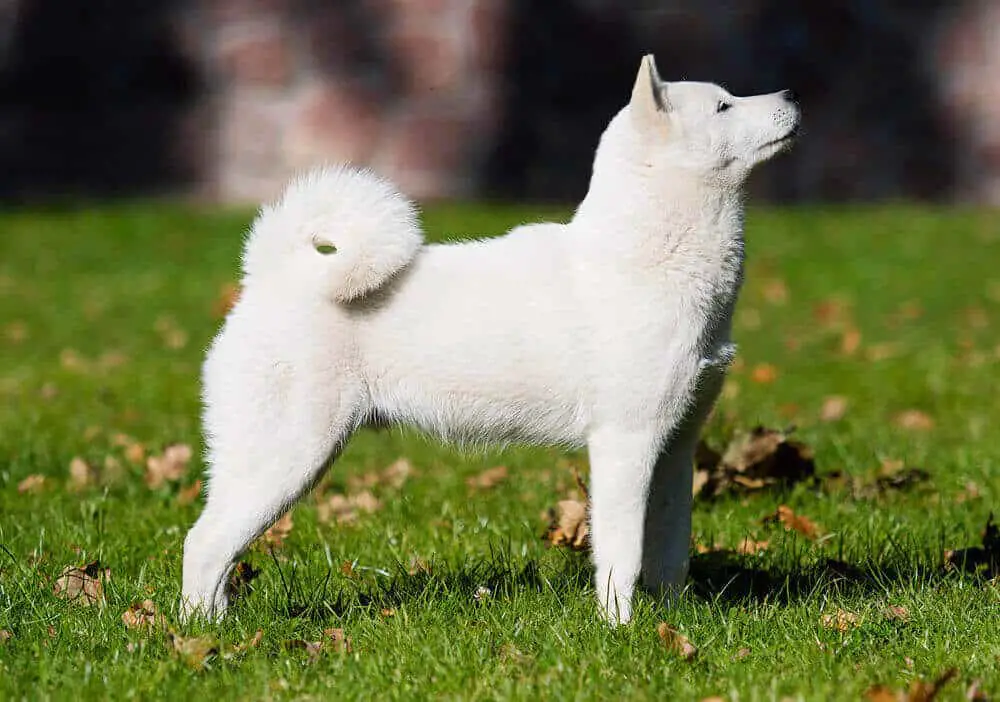
The Hokkaido Inu (also called Hokkaido Ken) isn’t very well known outside of its homeland Japan but is a beautifully coated, well-adjusted breed dawning robust features.
This is a breed that is historically a hunting dog. They are medium-sized solid dogs, generally docile but can be bold and alert.
Did You Know?
- The Hokkaido dog was kept well hidden from the rest of the world (outside of Japan) until 1869, when British Zoologist Thomas Blakiston discovered the breed.
- In 1937 the Hokkaido dog was officially listed as a National Natural Monument in Japan.
- The most famous Hokkaido dog went by the name of “Otousan” and appeared in various advertising campaigns for SoftBank in Japan.
9. Ryukyu Inu

The Ryukyu Inu is a medium-sized dog that is an extremely rare breed. The latest tally was that only about 400 individuals are left worldwide. Efforts are being made to prevent it from going by the wayside, as have another rare Japanese dog breed.
This breed is intelligent and well-mannered enough to be a loving family pet and an excellent companion.
With any luck, efforts made by those who care will succeed in removing the Ryukyu from being among the rarest Japanese dog breeds.
Did You Know?
- The Ryukyu Inu Hozonkai (Ryukyu Inu Preservation Society) is the only breed club currently recognizing Ryukyu.
- Ryukyu Inu has a declaw on the back of their foot. This helps them climb trees, resulting from evolution and years of living in the rainforest.
- As of 2015, it’s thought that there are fewer than 400 Ryukyu Inu dogs.
10. Shikoku Ken
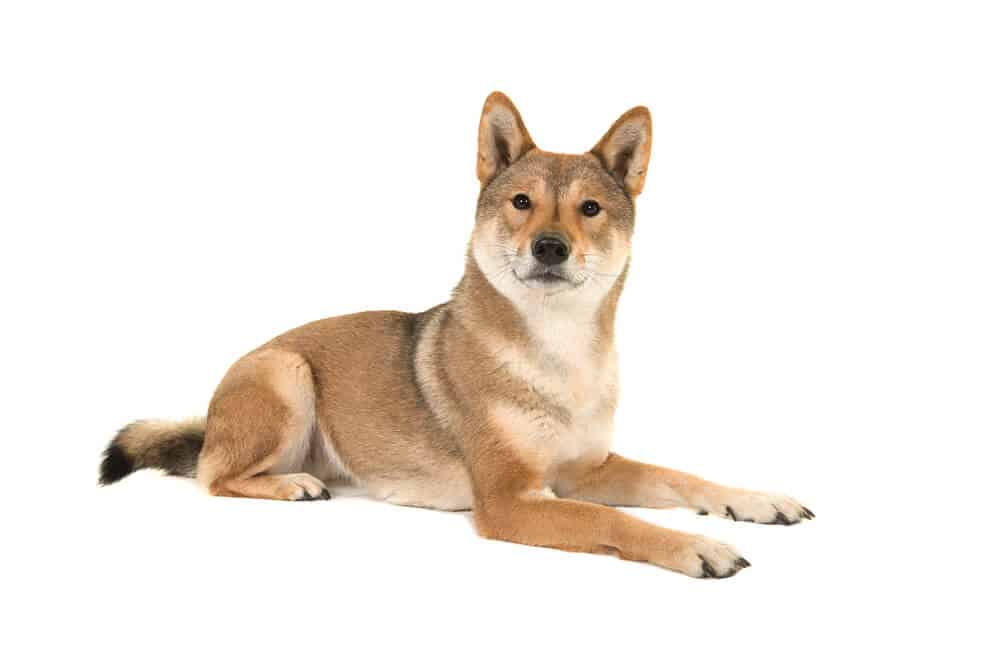
Like most breeds in this list, the Shikoku Ken (or Shikoku Inu) is a medium-sized breed held in high regard for its intelligence, endurance, and, particularly, its hunting skills.
Historically they were used for hunting down wild boar, amongst other varieties of prey, comparable to the hunting activities of Great Danes.
They are also described as having a naive sense of themselves and forming a close and loving bond with their family members. However, they will eventually gravitate toward one person in the bunch and be ever faithful to that person for life.
Did You Know?
- The breed is known for its outstanding athletic and acrobatic abilities, making them excellent escape artists.
- They are the ideal companion for active outdoor people because of their toughness and agility.
11. Sakhalin Husky

Also known as the Karafuto Ken, the Sakhalin Husky has been classified as extinct tragically. In 2015, the only dogs remaining were seven individuals dwelling in their homeland of Sakhalin, an island in Japan.
Their appearance is similar to what we see in Huskies today, dawning a thick fur coat.
Ultimately, this dog breed is no longer with us in its original, genetically pure form. Nonetheless, it deserves a spot on our list.
Did You Know?
- The Sakhalin Husky was brought to fame after the tragic 1958 Japanese expedition to Antarctica.
- Fifteen huskies were left tied up outside as researchers went on an unplanned excavation.
- Unfortunately, the cold weather prevented them from returning to the dogs, and they were left to fend for themselves.
- When a new group of explorers returned, two of the 15 dogs were still alive a year later. They were named Jiro and Taro.
12. Sanshu Inu

The Sanshu Inu is a new breed to Japan and was originally a combination of Chow Chow dogs and Japanese native breeds.
The result of this mix is what appears to be a small Akita with almond-shaped, dark eyes. This breed is currently enjoying a good amount of popularity across Japan.
Did You Know?
- The Sanshu Inu currently isn’t recognized by any kennel clubs. Most international breeders favor the more popular Shiba Inu.
- The Sanshu Inu is similar in size and appearance to another popular Japanese breed, the Akita. While they look identical, the Akita isn’t one of the breed’s ancestors.
- The breed is very popular in Japan, used as a protection dog and family companion.
13. Japanese Terrier
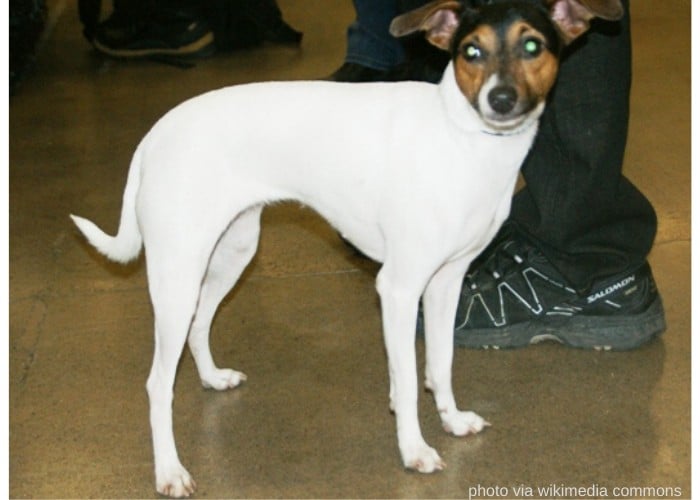
This breed is the first “Terrier” type canine within Japan, dating back to the early 1900s. This breed has a short coat, a black and tan head, and an all-white body. Otherwise, the dog is white from head to toe to tail.
They are small but good guard dogs, willing to raise the alarm at the first sign of trouble. These are intelligent, loyal, and independent dogs.
This was an extremely popular breed in Japan for many years until other foreign breeds were introduced around the mid-1900s when their numbers began to decline. Efforts are being made to help support the numbers of this small Japanese dog.
Did You Know?
- Japanese Terrier is rare, even in Japan.
- It is believed that they have German Pinscher, smooth fox terrier, and indigenous dogs’ DNA in their blood.
- The United Kennel Club recognized the Japanese Terrier in 2006
Final Thoughts
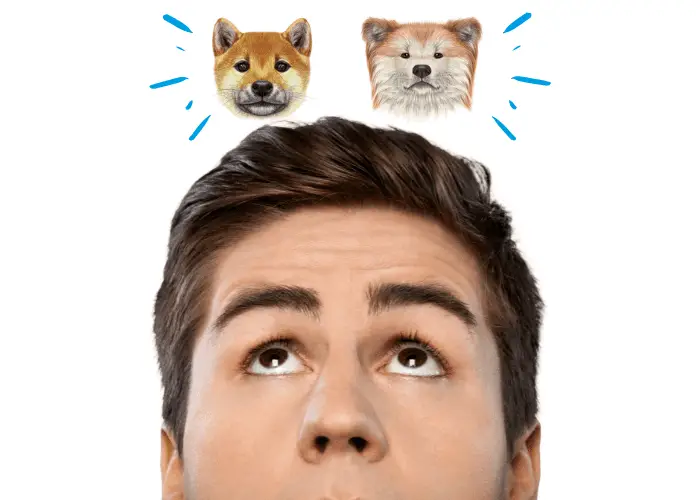
For thousands of years since the days of the Jomon people, Japanese breeds have captivated the hearts of native dog owners.
But when you look at the post-World War II numbers of these native dog breeds, it’s plain to see what the introduction of foreign breeds (mainly European breeds) did to the local canine populations.
Some Japanese canines have found homes successfully across the globe, while others are lesser-known- mainly popular in Japan.
Looking to train your dog in the Japanese language? –
Check out the Basic Japanese Dog Commands Article Now!
Breeds, beloved since ancient times, have lost their utility in recent years and have lost popularity and numbers. That notwithstanding, they are perceived by the Japanese as national treasures.
Of late, dogs of small size are in demand for the most part due to tight living quarters of over-populated areas, making it tough to be a large breed in their native country.
There are many good reasons why the Japanese are indeed a country of dog lovers who take pride in the historical significance they’ve brought to the table regarding various beautifully coated, hearty dog breeds.
It’s not too late to see more beautiful Asian Dogs from other countries below:


